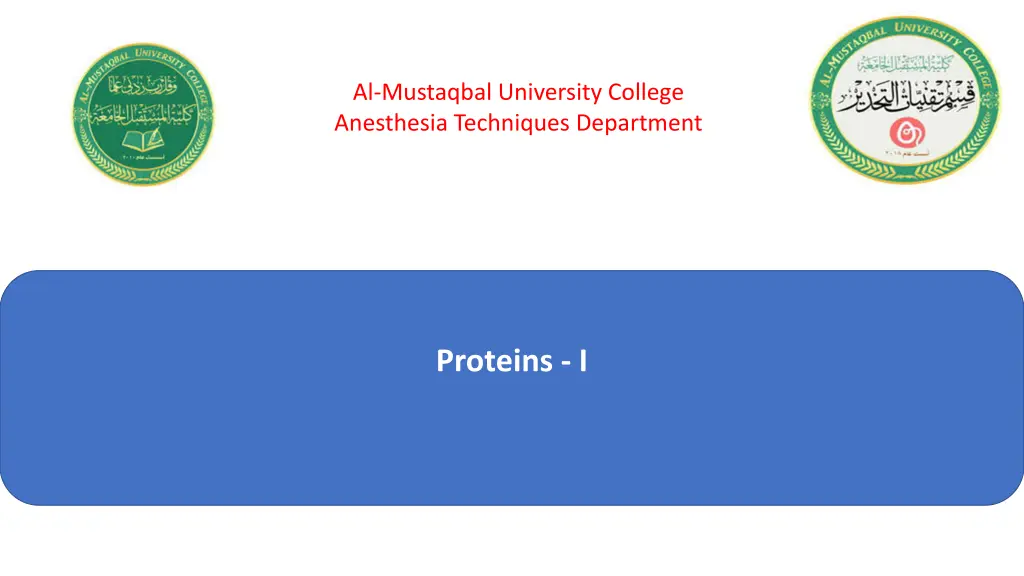
Understanding Proteins: Structure, Digestion, and Absorption
Discover the world of proteins and their significance in the human body. Learn about protein structure, digestion, absorption, and nitrogen balance to appreciate their role in maintaining health and vitality. Dive deep into the primary, secondary, tertiary, and quaternary structures of proteins, and understand how they are broken down during digestion to release essential amino acids for absorption. Explore the delicate balance of nitrogen in the body and its importance in protein metabolism.
Download Presentation

Please find below an Image/Link to download the presentation.
The content on the website is provided AS IS for your information and personal use only. It may not be sold, licensed, or shared on other websites without obtaining consent from the author. If you encounter any issues during the download, it is possible that the publisher has removed the file from their server.
You are allowed to download the files provided on this website for personal or commercial use, subject to the condition that they are used lawfully. All files are the property of their respective owners.
The content on the website is provided AS IS for your information and personal use only. It may not be sold, licensed, or shared on other websites without obtaining consent from the author.
E N D
Presentation Transcript
Al-Mustaqbal University College Anesthesia Techniques Department Proteins - I
Proteins Proteins Proteins are the group of organic compounds of carbon, hydrogen, oxygen and nitrogen. All the biologically active proteins comprise nearly 20 different amino acids, which are called building blocks of proteins. Proteins are chains of amino acids that are linked together by peptide bonds. Each protein has specific and unique sequence of amino acids
Structure Of Proteins Structure Of Proteins Proteins are made up of one or more polypeptide chains. Four levels of structural organization can be recognized in proteins: 1. Primary structure 2. Secondary structure 3. Tertiary structure 4. Quaternary structure.
Primary structure: Primary structure of proteins refers to the order and sequence of amino acids in a polypeptide chain in which these different amino acids are linked through the peptide linkage. Secondary structure: Folding or twisting of the large polypeptide molecule possessing primary structure forms the secondary structure (a-helix, b-pleated sheets). Tertiary structure: Refolding of the polypeptide chain possessing secondary level of structure like a-helix, b-pleated sheets, and random coils lead to the formation of tertiary structure Quaternary structure: Some proteins contain more than one- polypeptide chain. They are known as oligomeric (multi-subunit) proteins.
DIGESTION AND ABSORPTION OF PROTEINS DIGESTION AND ABSORPTION OF PROTEINS The protein does not undergo any digestion in the mouth. When it enters the stomach, it stimulates the secretion of the hormone gastrin, HCL and pepsin Pepsin secreted by chief cells as pepsinogen and later converted to pepsin by HCl. Pepsin converts protein into smaller peptides. When the acidic contents from the stomach pass into the small intestine it stimulate pancreatic secretion of proteolytic enzymes ( trypsin and chymotrypsin) for further digestion of proteins and peptides into amino acids which then absorbed by intestinal mucosal cells.
NITROGEN BALANCE NITROGEN BALANCE Catabolism of amino acids leads to a net loss of nitrogen from the body. This loss must be compensated by the diet in order to maintain a constant amount of body protein. Nitrogen balance studies evaluate the relationship between the nitrogen intake (in the form of protein) and nitrogen excretion. Three situations of nitrogen balance are possible as follows: 1. Nitrogen equilibrium In normaladults, nitrogen intake is equal to nitrogen excretion. 2. Positive nitrogen balance nitrogen intake > nitrogen excretion as in growing children and pregnancy 3. Negative nitrogen balance. nitrogen intake < nitrogen excretion as in burn and serious illness
Formation of Urea Formation of Urea Urea is the end product of protein metabolism. The nitrogen of amino acids removed in the form of ammonia is detoxified by converting it to urea. Formation of urea by urea cycle is an ultimate route for the metabolic disposal of ammonia. Urea is produced exclusively by the liver and then is transported through blood to the kidneys for excretion in the urine so urea can be used as a marker for assessment of renal function
Enzymes catalyzing the urea cycle reactions are distributed between the mitochondria and the cytosol of the liver The first two reactions of urea cycle occur in the mitochondria, whereas the remaining reactions occur in the cytosol.
Good luck Good luck






















